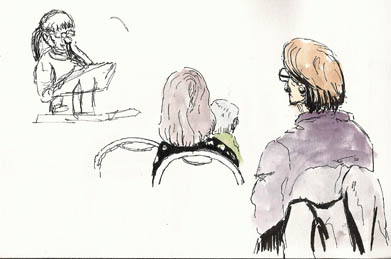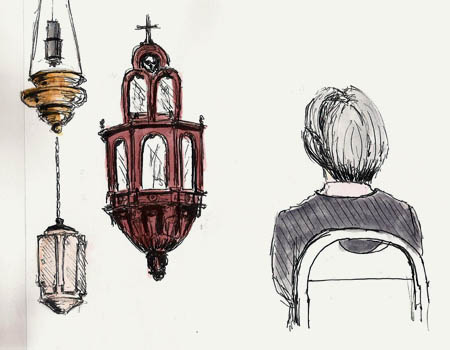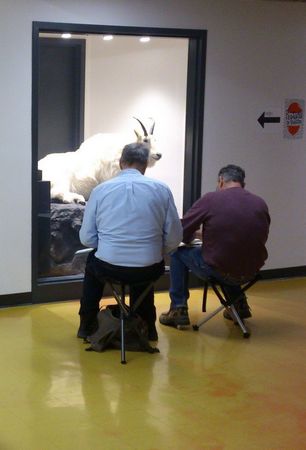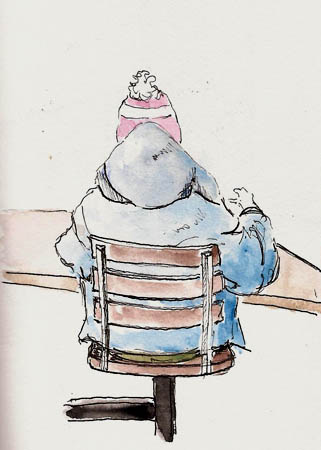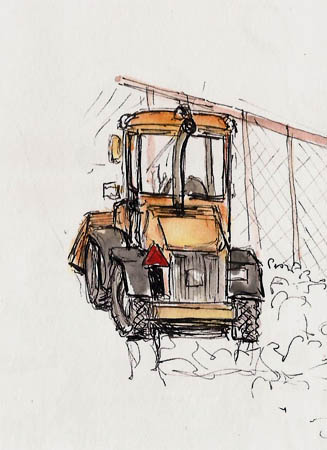 The golden age of sketching is upon us and books about it are flooding onto the market. They come in several forms.
The golden age of sketching is upon us and books about it are flooding onto the market. They come in several forms.
Lots of them are about inspiration and motivation. Seems there are a lot of folks who need to be goaded (the high-minded word is ‘inspired’) into having fun (grin). These include, however, a lot of great stuff to dismiss the myths that you have to have special genes to draw and have fun drawing. These books are probably more responsible for the sketching revolution going on than anything else.
Then there are those books that illustrate, quite literally, what it is to be an urban sketcher, nature journalist, etc. Typically these are compiled by one artist using their sketches and those from a large number of other sketchers so you get a good sampling of the styles, approaches, and subject matter associated with a particular form of sketching.
Finally there are instruction books. These books try to teach you how to sketch or how to do some particular type of sketching. As has always been the case in art book land, the majority of instruction books assume you don’t know anything about art or drawing and so spend a lot of their time telling you about color wheels, which end of the brush is the good end, and stuff like that.
Fortunately, we’re starting to see a few instructional books that assume you know something about putting pen/pencil to paper and they concentrate on particular techniques and approaches to sketching. As someone who has been sketching for a while, I welcome these books the most and Lynne Chapman’s Sketching People: An Urban Sketcher’s Guide to Drawing Figures and Faces fits into this category and I can’t recommend it enough to those wanting to improve your ability to sketch people on location. I’d even go further and recommend it to anyone wanting to improve their ability to sketch on location regardless of subject.
Production Excellence
This is not something most reviews would say much about, though more and more we’re seeing reviewers talk about the number of typos they find in books. The publishing world has been shedding editors like crazy and the impacts have become evident to anyone who is a fan of the written word. So, I want to talk about, and applaud, how Lynne Chapman and her publisher, Search Press have produced a book that is considerably better than the norm in several ways.
First, there are no typos, at least none that I saw. There are no captions on the wrong graphics. There are no grammatical errors. One caveat here is that I ordered my book from Book Depository in the UK because Amazon Canada claims that the book is not available yet. So mine is the British version of the book. In any case, this book is spotless as a result of good copy editing and proofing processes.
The book layout is simply amazing. This book is packed with information and yet all of it is readily accessible. The number of graphics they’ve managed to pack into the book, when compared to most others is wonderful, but more importantly it allowed Lynne to include a ton of information associated with those graphics in the form of paragraph-size captions.
Lastly, the overall book organization is superb. Each chapter, or set of sections leads well into the next and the knowledge gained from one chapter is built upon in subsequent sections. There’s one tiny exception…I had to find at least something to grouse about. Lynne uses a limited number of colored pencils in many of the example sketches and it’s impossible not to be asking “what colors are those” throughout the book. The answer to that question comes near the end of the book, in a section about using a limited palette. I would have liked to have known those colors sooner. This is a tiny thing, however, as the book should be a model for what other publishers should be doing.
Getting Started
The first section, Getting Started, introduces the idea of sketching people with discussions of urban sketching, why sketching people is not only fun but possible and Lynne throws in a dash of ‘don’t be afraid…people like it when you sketch.’ This last point is always a hard thing to sell to anyone who hasn’t done it and one of those ‘yep, she’s right’ for anyone who has.

The book then launches into a series of short sections on how to draw ears, eyes, noses, hair, clothing, etc. and I love these sections because they’re presented by a sketcher for a sketcher. Most books on drawing body parts come from people who do portraits and while a fully rendered nose is a sight to behold, it’s hard to translate those techniques to a much quicker line drawing done on location. Lynne bridges that gap with these sections, showing different methods of drawing human parts in a short period of time.
At this point I should say that I think this book is about two things. It sort of says so in the title, Sketching People: An Urban Sketcher’s Guide to Drawing Figures and Faces, and while it is about figures and faces, it’s also about drawing quickly and drawing when you have more time. When Lynne is on a train she’s got 15-20 minutes to draw faces. When she’s in a farmer’s market, she’s got no more than a minute or so to capture a human, trying to incorporation the action of the moment.
These different circumstances require different approaches, different emphasis on some parts while letting others take a back seat. All that follows the Getting Started section tries to navigate these shifts in approach and Lynne does a great job of providing tools to accomplish it and examples where she has done it.
Sketching Out in the Big Wide World
 For me this is a fun section. At its core it’s a section that suggests different places where you can sketch people on location and it presents examples of just that. Lynne adds much more. She talks about the challenges of each venue, vantage points, choosing subjects, particular actions and attributes of people in that venue, and how to capture them on paper. I just had to include a photo of the page below as the pretty lady with a bunch of green pads on her head is Lynne herself, a selfie she drew from a mirror as she waited for her highlighting to take.
For me this is a fun section. At its core it’s a section that suggests different places where you can sketch people on location and it presents examples of just that. Lynne adds much more. She talks about the challenges of each venue, vantage points, choosing subjects, particular actions and attributes of people in that venue, and how to capture them on paper. I just had to include a photo of the page below as the pretty lady with a bunch of green pads on her head is Lynne herself, a selfie she drew from a mirror as she waited for her highlighting to take.
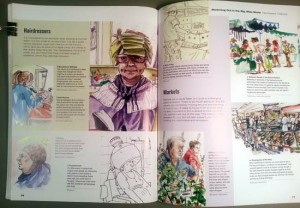
Different Styles and Approaches

ln this section Lynne puts the heart of the location sketcher, or maybe their brain. She talks about different styles, like Creative Color, Fluid Lines, and Less is More and other sections on how to quickly plan a sketch, how to paint first, draw later, and even how to place people in their environment. If you haven’t done a lot of street sketching, you’ll find this section valuable whether you draw people or not.

 People Move!
People Move!
The achilles heel of people sketchers – those darn humans move when you’re trying to draw them. But consider the alternative. Better yet, experience it. Ask someone if you can sketch them. If they agree, they’ll stop moving. They’ll also stop being human as they sit up straight, look off into the distance and try to look regal. And then you’ll know – moving people aren’t so bad afterall.
Learning to work quickly is the answer to sketching moving humans and Lynne provides some tricks of the trade to help you do just that. She provides some basics about drawing quickly, talks about capturing poses that repeat and even about how to build composite characters as streams of humans move past you, all doing similar things.
Summary
This book is powerful and should be part of every location sketcher’s library. I confess that as a fountain pen guy, I admire Lynne’s multi-color style for sketching people and I ran out yesterday and picked up some Derwent Inktense pencils to give it a try. Maybe I’ll read her book again, copy a few of her sketches, and then hit the streets.
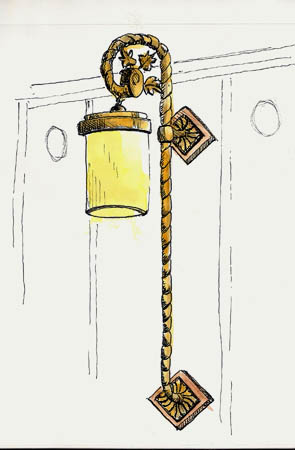 Winter persists and so does this sketcher. I met Yvan at the chapel associated with the Musée d’Amerique Francophone. It’s warm and there are lots of woodcarvings and fixtures to challenge a sketcher.
Winter persists and so does this sketcher. I met Yvan at the chapel associated with the Musée d’Amerique Francophone. It’s warm and there are lots of woodcarvings and fixtures to challenge a sketcher.
